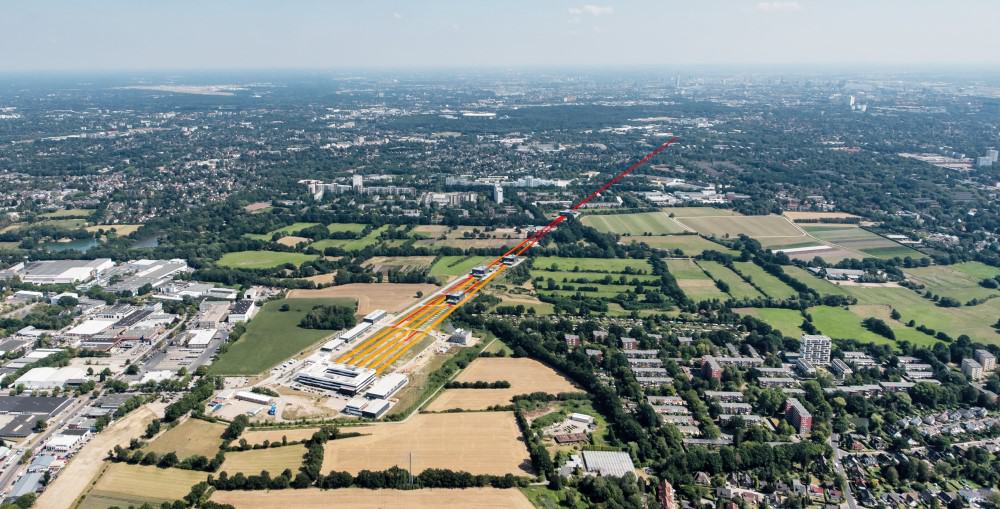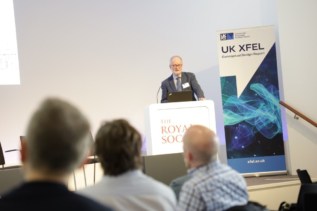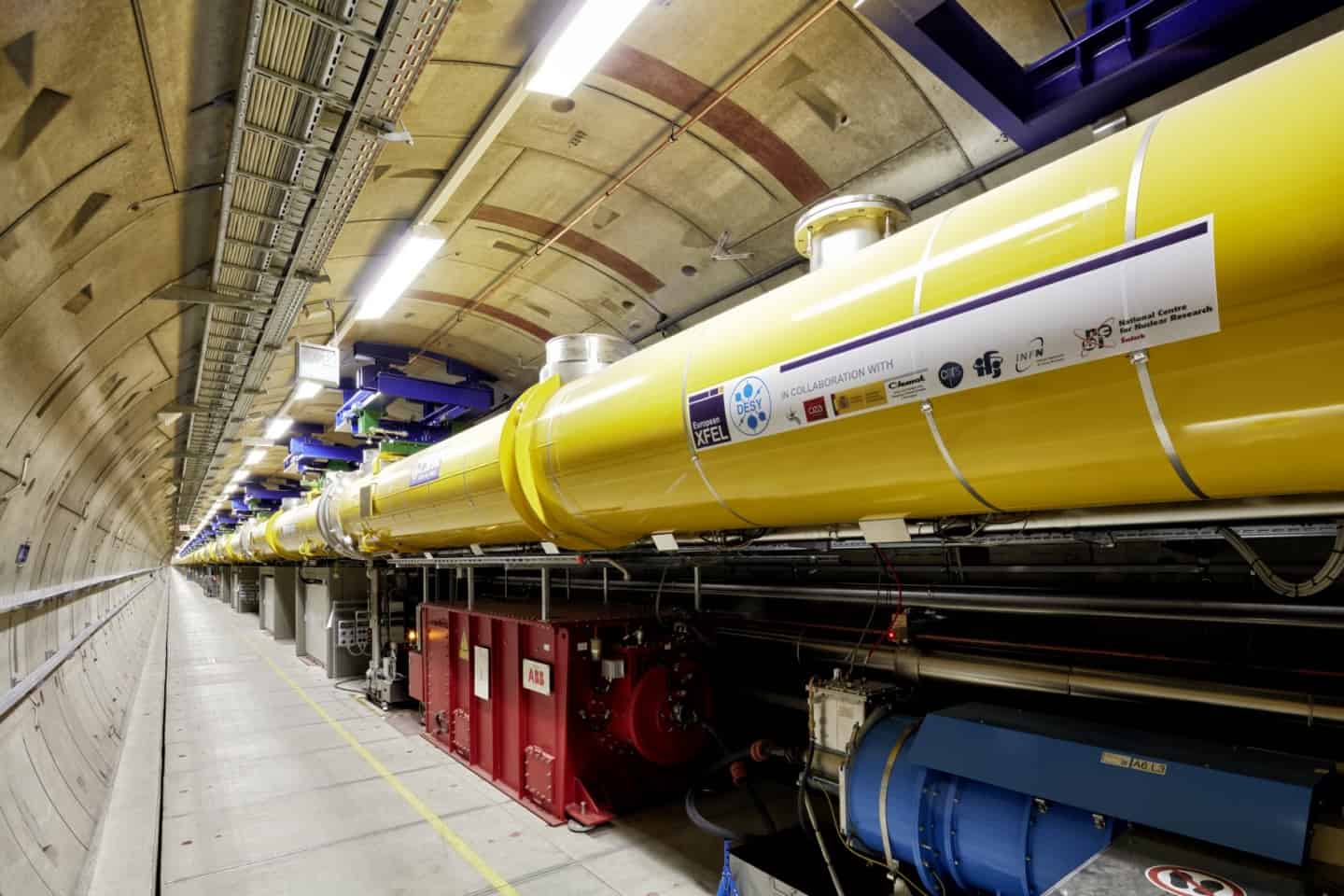
The UK has officially launched the start of design work for a next-generation X-ray free-electron laser (XFEL) facility. Over 150 researchers met at the Royal Society on Monday to discuss plans for the UK-based XFEL that, if given the go-ahead, could be built in the coming decades. Researchers will now hold a series of meetings across the UK to gauge interest in a facility and discuss what kind of science it may produce.
While synchrotrons use X-rays to produce static images, or snapshots, of a sample under investigation, XFELs can study dynamical processes because they generate pulses of intense, coherent X-ray beams tens of thousands of times per second (see box below). Each pulse lasts less than 100 fs (10–13 s), which means that researchers can, for example, create “movies” of chemical bonding processes or analyse the way vibrational energy flows across a material.
XFELs are not new, with the first such facility to come online being the Linac Coherent Light Source (LCLS) at the SLAC National Accelerator Laboratory in the US. Construction began in 2005 and was completed four years later. The facility is now undergoing a major upgrade – known as LCLS II – that will involve boosting the number of X-ray pulses per second from 120 in LCLS to one million in LCLS II.
Other XFELs soon opened in Japan, Germany, South Korea and Switzerland, meaning that there are now five such user facilities around the world. In 2008 the UK also began to look into hosting a dedicated XFEL but the plans failed to gain traction. The UK instead chose to join the European X-ray Free Electron Laser (European XFEL) at the DESY lab near Hamburg, Germany.
The European XFEL, which achieved first light in 2017, features a 2.1 km superconducting linear accelerator that can accelerate electrons to 17.5 GeV. The facility produces pulses of X-rays 27,000 times per second, with each pulse lasting less than 100 fs. In 2022 more than 120 articles were published based on experiments performed at the facility.
The UK was initially involved with the European XFEL by developing technology, designing instruments, contributing to construction and joining user consortia. The UK’s Diamond Light Source in Oxfordshire also hosts two “XFEL hubs” – in the physical and life sciences – where UK users of the European XFEL are given support in terms of training, sample preparation and data processing.
In 2018 the UK then became the 12th country to join the European XFEL, contributing some €26m – or 2% – towards the cost of building the €1.22bn (2005 equivalent prices) facility. The UK also began to pay 2% of the annual operating costs of the facility, although that figure has now risen to 7%, with the UK being involved in a similar percentage of experiments.
The operational costs of an XFEL facility can be significant. The European XFEL, for example, has an annual running cost of €140m, meaning that the 100 experiments carried out at the facility last year each cost about €1.4m to carry out. But with the European XFEL being five times oversubscribed, there is still capacity for more machines and in 2015 the UK began to re-examine the case for its own XFEL.
Build your own

As a result of the growing demand for XFELs, the Science and Technology Facilities Council (STFC) – one of the nine research funding agencies in the UK – conducted a free-electron laser strategic review, which it completed in 2016. The review concluded that the UK should ensure it is in “a position to take the final decision on whether to build an XFEL” by 2020.
The UK missed that deadline but did publish a UK XFEL science case that year. More than 100 scientists from around the world helped to draft the report, which recommended the UK build a machine capable of producing X-rays with an energy between 0.1 keV and 150 keV and a pulse duration of 100 attoseconds to 1 fs, allowing for new regimes to be explored.
How XFELs look in 2030s or 2040s may be very different to what they look like today
Mike Dunne
In October 2022 the UK XFEL proposal was boosted by £3.2m from UK Research and Innovation – the umbrella organization for the UK’s nine research councils – to carry out a conceptual design review. It is expected to take some three years to complete and will also involve updating the science case. According to physicist Ian Walmsley, provost of Imperial College London, the review is an “important step” for the project.
During the event at the Royal Society, which was also attended by some 150 people online, scientists outlined what a new facility might investigate. This includes quantum materials, dynamic structual biology and even, as physicist and XFEL user Emma McBride from Queen’s University Belfast explained, getting a better understanding of the conditions inside planets.
David Dunning, a physicist from the Accelerator Science and Technology Centre (ASTeC) at the STFC-Daresbury Laboratory, notes that a UK XFEL operating an 8 GeV superconducting linear accelerator “would cover a lot of the science base” that came out of the survey of potential users. But that energy requirement will now be investigated in greater detail during the conceptual design review.
Community engagement
A survey of research groups in the UK, conducted as part of the UK XFEL science case, indicated that over 500 UK scientists have had active involvement in XFEL science in the last decade. But Jon Marangos from Imperial College London, who is UK XFEL’s science lead, says it will be crucial in the coming years to broaden the engagement of the scientific community to make sure that XFEL science does not turn into a clique of users.

As part of the conceptual design review, a series of “town-hall” style events and workshops will now be held around the country. STFC hopes these meetings will bring the community together and let it explain to scientists about what these machines can do. One event is expected to take place every three months until the end of 2024.
A key theme to emerge at the Royal Society meeting was the need for the UK to think as early as possible about the necessary regulatory process, given that a UK XFEL will probably have to be built, at least in part, in a greenbelt area. Jim Clarke from ASTeC highlighted that sustainability will also be a key part of the design. This could include, for example, using superconductors for radio-frequency cavities that can operate effectively at temperatures above 2 K.
Officials at the London event were keen to acknowledge that the main requirement for a UK XFEL is that it should have capabilities not currently possible elsewhere. That view is backed up by LCLS director Mike Dunne, who told delegates that innovation will be key when designing a next-generation facility. “How XFELs look in 2030s or 2040s may be very different to what they look like today,” he says.
We are only beginning to scratch the surface of what these machines can do
Emma McBride
The decision to start work on a conceptual design review does not, however, mean that a UK XFEL will be built. As speakers at the Royal Society meeting made clear, the review might conclude that the machine is too expensive and that a better option would be to support developments and deepen ties at another facility.
But if a UK-based option is deemed the best bet and there is funding available, the next step would be an engineering design on the favoured design. Although users may have to wait several decades to start experiments on a UK XFEL, the machine could offer much to science. “We are only beginning to scratch the surface of what these machines can do,” notes McBride.
How an X-ray free-electron laser works
XFELs work by accelerating bunches of electrons in a linear accelerator to gigaelectronvolt (GeV) energies. The electrons are then passed through “undulators” that cause the electrons to follow a sinusoidal path and emit synchrotron radiation in the process. As the photons are initially incoherent and concentrated over a narrow range of wavelengths, the light is amplified into coherent laser light by a process known as self-amplified spontaneous emission.
As the electrons travel through the undulator, the light they emit interacts with electrons following behind and this interaction accelerates or decelerates the electrons depending on their position and the phase of the light. The net result is that the electrons bunch up as they travel and thus produce light in phase and with a higher intensity.
This method gives an X-ray peak brilliance at XFELs some 10 orders of magnitude greater than existing “third generation” synchrotron light sources. The wavelength of the light can also be easily changed by controlling the energy of the electron beam in the linear accelerator or the magnetic field of the undulators to produce X-rays with a wavelength as small as 0.1 nm.
